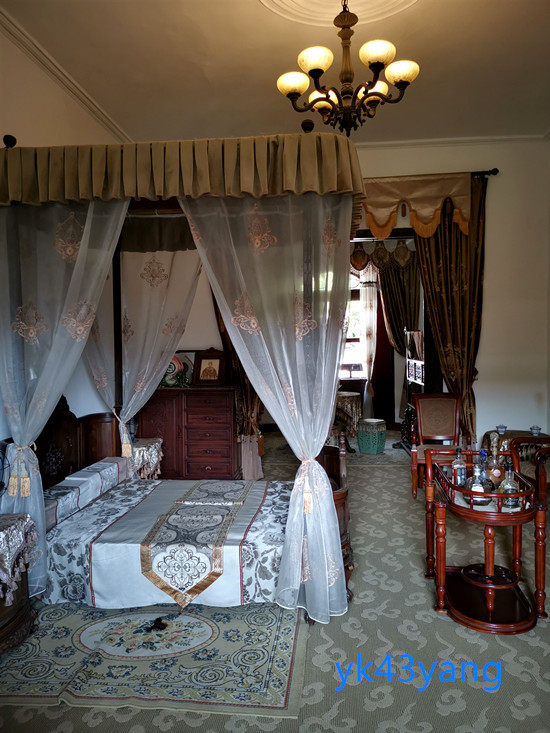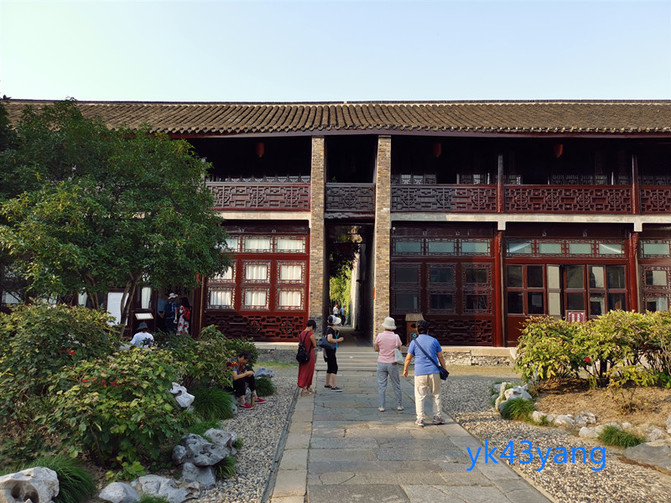Yangzhou Travels (2) - He Yuan (Middle)
Shuixin Pavilion is the theater pavilion of He Yuan. There is a platform in front of the pavilion where the theater troupe performs. You can watch from both the Butterfly Hall and the two-level corridor. The music of silk and bamboo comes from the water surface, which can be described as indescribable!


There are also rockeries made of the Taihu Lake Lake rocks around the pool in the West Garden. The interplay of mountains and waters is like a painting.

From the second floor of the winding corridor, you can directly walk to the second floor of the Jade Embroidery Building.


Yuxiu Tower is the residential courtyard of He Yuan. The Yuxiu Building consists of two two-story buildings in the north and south, connected by a two-story corridor to form a circular courtyard. The middle courtyard is planted with magnolia and hydrangea trees. The name of jade embroidery comes from this.
This magnolia tree stands tall and straight, with verdant leaves, and is also one of the treasures in the garden. This tree species comes from North America and was distributed by Empress Dowager Cixi to the meritorious personnel of the Huai Army. He Zhizhen was fortunate enough to have two plants planted here, which has a history of over 145 years. In the 1950s, some people found that the canopy of the magnolia tree was too large and blocked the sunlight upstairs, so they cut down one on the east side. The existing tree has become a target for tourists to admire and take photos.

The hydrangea tree in the center of the courtyard is also 145 years old and, like the magnolia, is a famous ancient tree in Yangzhou city. The hydrangea tree is a symbol of love, as well as the hope of life and the harmony of family.
The Yuxiu Building is where the owner's home resides. The north building is the residence of He Zhiqing, while the south building belongs to her children. Some rooms still exhibit scenes from that time. As for whether it is the original object, it is unknown.




I went downstairs to the courtyard and took a few photos. Then, passing through the cave entrance, we arrived at the courtyard in front of the Moon Viewing Tower.

The Moon Viewing Tower, also known as the Yixuan Tower, is a small two-story building with three rooms. Because this is the best place to admire the moon, it is called the 'Moon Viewing Tower'. The Moon Viewing Tower is where He Zhizhen's mother lives.
The first floor of the Moon Appreciation Tower is also known as the Tongren Pavilion. The two characters "Tongren" refer to a school founded in He Yuan called Tongren Middle School. And Tongren Hall was once a classroom in Tongren Middle School.
The courtyard floor is paved with pebbles to create patterns of prosperity, longevity, and phoenix offerings, reflecting the owner's interests and pursuits. The rockery in front of the courtyard is exquisite and graceful, an extension of the rockery in Xiyuan.

The ancient privet tree in the courtyard is over a hundred years old. It is said that He Zhizhen planted it specifically for her mother, which is a "filial piety tree".

This is the rockery in front of the Moon Viewing Tower:

Passing through the entrance of the Moon Viewing Tower courtyard, we returned to the West Garden. Just now I was overlooking the West Garden from the second floor, and now I'm taking another tour on the ground.
Arriving at Shuixin Pavilion, there is a curved bridge that leads to the pavilion. The decoration of Shuixin Pavilion is extremely exquisite, no wonder it can boast of being the "number one in the world"!

Watching the Butterfly Hall across from the water.

Arriving at the lower level of the winding corridor. There are many flower windows of various shapes on the walls of the corridor. From each flower window, one can see different views of the garden, just like a series of paintings.
The flower windows in the corridor are also a unique feature of He Yuan, known as the "number one window in the world".




From these few flower windows, you can see the north building of Yuxiu Tower next door. There is also a mysterious century where every flower window corresponds to every window on the jade embroidered building. Miss can sit upstairs and listen to the music coming from the performance of Shuixin Pavilion through the flower window.
We arrived at the Xuchun Hall south of the Yuxiu Tower.



The Xuchun Hall is a hall where the host receives VIP guests, using precious nanmu architecture, hence commonly known as the "Nanmu Hall". This is the largest and most well preserved Nanmu Hall in Yangzhou.
Wuxi Meiyuan also has a Nanmu Hall, but only the main beam of the hall is made of Nanmu. And this one, on the other hand, is entirely made of nanmu wood for the entire hall. It can be seen that the He family has strong financial resources!
The Xuchun Hall has a width of five rooms, a gable top, and a corridor in front of the hall. There is a couplet hanging on the central pillar: "Retired scholars spend their whole lives eating quinoa and amaranth, scattered for thousands of miles in the world of rivers and lakes. This was written by He Shaoji, a poet and calligrapher of the late Qing Dynasty.
The huge window glass used in the hall is 9 millimeters thick and is said to be imported from France, which is very expensive. In the center of the hall hangs a plaque reading "Xuchun Hall", with couplets on both sides that read: "Do not let the good days of spring and autumn pass; the most difficult time is for old friends to come through wind and rain", written by the Qing Dynasty scholar Sun Xingyan.
Nanmu Hall turns east and then south to reach the south exit. We walked north from the south gate and arrived at this equestrian building.

The Horse Riding Tower is a symmetrical building that combines Chinese and Western styles. It is divided into two floors, east and west, by a central alleyway, resembling a saddle, hence the name Horse Riding Tower.
Entering from the middle alley, there are two buildings behind, the East Second and East Third Floors. The three buildings are connected in front and back, and connected on both sides, which is quite spectacular.
The Horse Riding Tower is the guest house of the He family, used to entertain guests. The famous Chinese painting master Huang Binhong has visited Yangzhou six times and resides on the east first floor of the Horse Riding Tower. Mr. Zhu Qianhua, a famous writer, lived on the second floor of He Yuan East for five years.
On the east side in front of the Horse Riding Building is the fourth part of He Yuan - Pianshi Mountain House.
